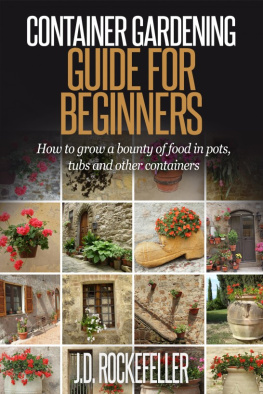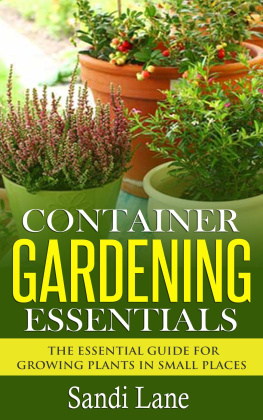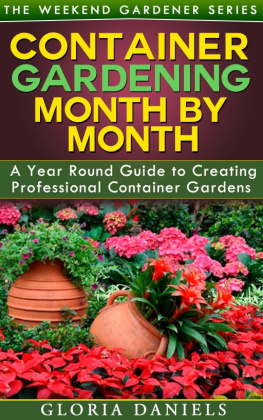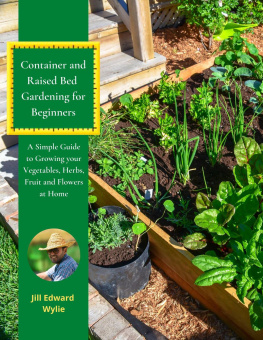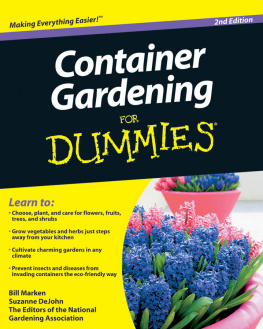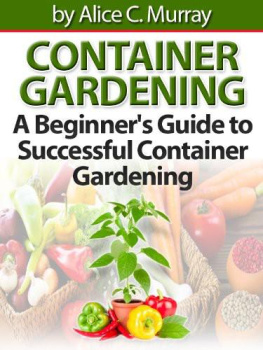Contents
Page List
Guide
Cover
CLAUS DALBY
CONTAINERS
IN THE GARDEN
Contents
Foreword
I have written a number of books on gardens, flowers, and decorations. It may sound odd that I can go on and on about plants, but I can. I love to communicate, especially in books.
Containers in the garden is a subject that I have worked on intensively over the years and continue to develop. Thats why this is my fourth book on potted gardens.
There is a lot of interest, I sense, and this is certainly linked to the fact that it is a good place to start. For many, it can seem overwhelming to set out to building an entire garden. In contrast, its a lot quicker and easier to plant some pots and arrange them. However, pots also require care. Watering, in particular, can be quite a challenge. So during vacations, you will have to enlist the help of friends or family.
Over time, I have become known for my passion for colors and my way of combining them. Naturally in the arrangement of flowers, but also very much in the use of foliage. They are great for creating breaks and for accentuating the flowers. Throughout the book I make a number of suggestions for plants whose foliage fits beautifully into a given color scheme. Often I feel like a fashion designer who is creating a collection that in many ways needs to fit together. It is my wish to pass on the knowledge and experience that I have acquired over many years.
Finally, I would like to thank you for the immense interest you have shown in my work on social media, where I regularly report on my life and work. It makes the process less lonely and its nice to be reassured that youre on the right track.
A very big thank you also goes to my gardeners and other helpers, who are invaluable in my work.
Claus Dalby
clausdalby.com @clausdalby
My Containers
Almost all my pots are made of light terracotta clay, which takes patina well. Although these days there are many new materials that make the containers light and able to stand outside in winter, my favorite material is still clay. And let me be clear: there are no clay pots that are one hundred percent frost-proof! Some are more vulnerable than others; it depends on how hard theyre fired. Hard-fired pots dont soak up as much water as pots fired at lower temperatures. And since it is the water that freezes and causes the pot to burst, extra care should be taken with pots that have been fired at lower temperatures.
In any case, the safest thing to do in autumn is to empty the clay pots of plants and potting soil and place them slightly raised above the ground with the bottom up. Then there is not much risk. Even better is to place the pots under a canopy, in a shed or perhaps a greenhouse.
If it is not possible to remove the soil because the plants will spend the winter in the pot, the danger of bursting is minimized by placing the pots under cover so that they do not get winter moisture.
If you use zinc or wooden containers, leaving them outside is not a problem. And the same is true for most fiber materials.
As for the look of the pots, it is of course a matter of taste, what you prefer. My taste has always been toward the unadorned and relatively stylish. If you look at the range in garden centers and nurseries, this is also the kind that is prominent today. In the past you could buy cheap glazed pots, often with carved motifs, but they seemed so strangely alien.
If you like pots and live by the motto that there is always room for one more, I can only recommend that you keep your eyes open. Not only when you are in the garden center or at the nursery, but also in the DIY store, department store, interior design store, second-hand shop, or at flea markets.
The Good Soil
It goes without saying that the soil in which plants grow must be of the best quality. Here, no expense shall be spared.
With soil, as with so much else, quality costs, so dont go for the cheapest product. After all, its about plants thriving throughout the season, and they will only do so if the soil is of a quality that allows them to develop a good root network. You have to feel your way.
It may be possible to open a sack to check the soil: pick up a handful of potting soil and close your hand tightly around the soil. Then open your hand again. If the soil is compressed, it will not be suitable, but it also should not be so loose that it falls apart. An intermediate consistency is appropriate. When doing this little test, it is important that the bag has not been open so long that the soil has become dry. It should be slightly damp.
If the potting soil is easily compressed, it will naturally also form a large lump in the pot. This squeezes out the air, preventing oxygen from reaching the roots and causing the plant to die.
Another clue to the quality of the soil can be found by looking at the color. It should not be too dark, but not too light either. A nice chocolate brown color is usually a sign of quality. Good potting soil often contains vermiculite or perlitesmall particles of expanded volcanic rocks that help to hold water and fertilizer. The soils label will tell you whether the soil contains vermiculite or perlite.
For many years I was asked what kind of soil I used. But it was quite difficult to answer, because I used a professional grade that was not available to ordinary people. It was only for professional gardeners, yet I was lucky to get my hands on it.
Source a professional-grade potting soil that contains vermiculite or perlite. Ideally, it should also contain compost, composted cow manure, or another long-acting fertilizerenough for a whole season. Its what makes the plants strut.
Plants from Seeds
Ever since I started taking an interest in gardening, Ive loved propagating plants from seed. Even before the first seed catalogs arrive in the mail, I have to go online to see if the new selections have appeared on the various websites. Its always exciting to see whats new, and interesting things pop up every year. But the good old ones are not to be snuffed at either. There are plants that I have in my rotation every year.
You can buy a lot of plants, and I do, but its really special to grow them yourself. For me, one of the most essential things about gardening is sowing a seed and watching it sprout and grow. Its basic and fundamental and I think it speaks to our primordial brain.
Another joy of seed propagation, of course, is that you can grow many plants that arent available commercially. There is so much to choose from.
There is a big difference in how long it takes for a seed to develop into a flowering plant. For some its quite quickeight to ten weeks. These are the annual plants that can be sown directly at the growing site. Thats why theyre called hardy. If youre buying seeds, its handy to know that this group is called Hardy Annualsin seed catalogs sometimes abbreviated HA.


